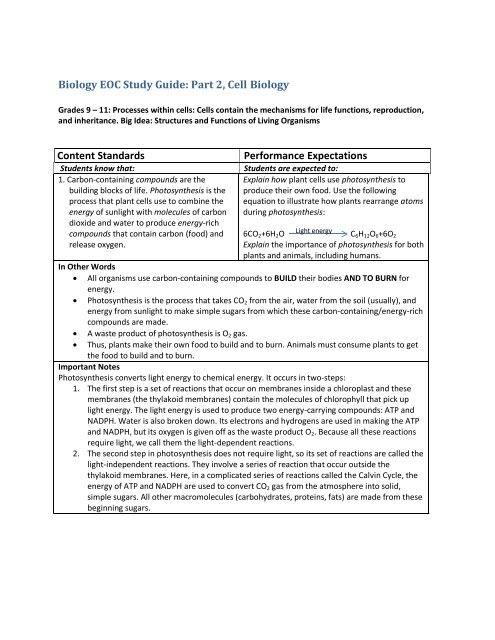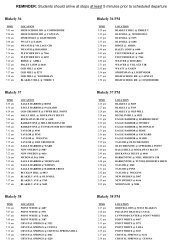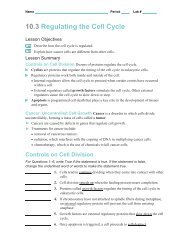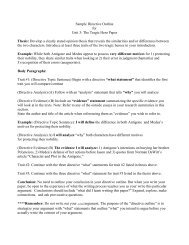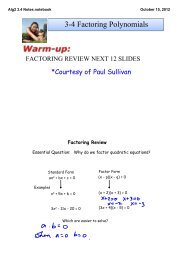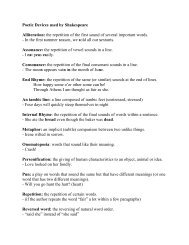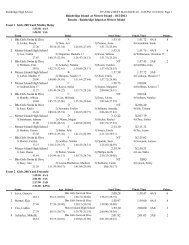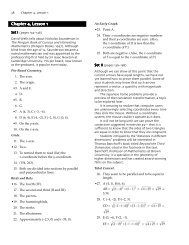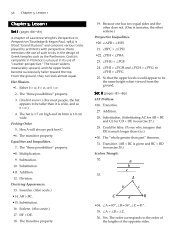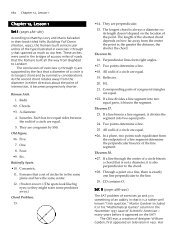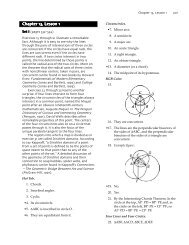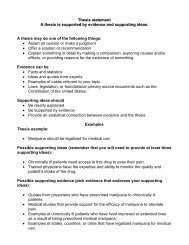Biology EOC Study Guide: Part 2, Cell Biology Content Standards ...
Biology EOC Study Guide: Part 2, Cell Biology Content Standards ...
Biology EOC Study Guide: Part 2, Cell Biology Content Standards ...
Create successful ePaper yourself
Turn your PDF publications into a flip-book with our unique Google optimized e-Paper software.
<strong>Biology</strong> <strong>EOC</strong> <strong>Study</strong> <strong>Guide</strong>: <strong>Part</strong> 2, <strong>Cell</strong> <strong>Biology</strong><br />
Grades 9 – 11: Processes within cells: <strong>Cell</strong>s contain the mechanisms for life functions, reproduction,<br />
and inheritance. Big Idea: Structures and Functions of Living Organisms<br />
<strong>Content</strong> <strong>Standards</strong><br />
Students know that:<br />
1. Carbon-containing compounds are the<br />
building blocks of life. Photosynthesis is the<br />
process that plant cells use to combine the<br />
energy of sunlight with molecules of carbon<br />
dioxide and water to produce energy-rich<br />
compounds that contain carbon (food) and<br />
release oxygen.<br />
Performance Expectations<br />
Students are expected to:<br />
Explain how plant cells use photosynthesis to<br />
produce their own food. Use the following<br />
equation to illustrate how plants rearrange atoms<br />
during photosynthesis:<br />
6CO 2 +6H 2 O Light energy C 6 H 12 O 6 +6O 2<br />
Explain the importance of photosynthesis for both<br />
plants and animals, including humans.<br />
In Other Words<br />
All organisms use carbon-containing compounds to BUILD their bodies AND TO BURN for<br />
energy.<br />
Photosynthesis is the process that takes CO 2 from the air, water from the soil (usually), and<br />
energy from sunlight to make simple sugars from which these carbon-containing/energy-rich<br />
compounds are made.<br />
<br />
<br />
A waste product of photosynthesis is O 2 gas.<br />
Thus, plants make their own food to build and to burn. Animals must consume plants to get<br />
the food to build and to burn.<br />
Important Notes<br />
Photosynthesis converts light energy to chemical energy. It occurs in two-steps:<br />
1. The first step is a set of reactions that occur on membranes inside a chloroplast and these<br />
membranes (the thylakoid membranes) contain the molecules of chlorophyll that pick up<br />
light energy. The light energy is used to produce two energy-carrying compounds: ATP and<br />
NADPH. Water is also broken down. Its electrons and hydrogens are used in making the ATP<br />
and NADPH, but its oxygen is given off as the waste product O 2 . Because all these reactions<br />
require light, we call them the light-dependent reactions.<br />
2. The second step in photosynthesis does not require light, so its set of reactions are called the<br />
light-independent reactions. They involve a series of reaction that occur outside the<br />
thylakoid membranes. Here, in a complicated series of reactions called the Calvin Cycle, the<br />
energy of ATP and NADPH are used to convert CO 2 gas from the atmosphere into solid,<br />
simple sugars. All other macromolecules (carbohydrates, proteins, fats) are made from these<br />
beginning sugars.
What to look out for:<br />
All cells need ATP for energy. So why not just use the ATP made in photosynthesis as the<br />
source of all ATP needs or all organisms Because ATP doesn’t last very long, AND it cannot<br />
go through cell membranes to get to the other cells that need it (like in the roots of plants).<br />
So plants store the energy in the form of sugar (which lasts a long time and can be delivered<br />
to other cells).<br />
PLANTS ARE NECESSARY; ANIMALS ARE OPTIONAL. Remember!!! Plants are making this<br />
sugar energy and oxygen waste for themselves, not for animals! Plants will burn the sugar<br />
(with the aid of the oxygen waste) in the mitochondria of their own cells to produce the ATP<br />
they need to survive. It’s just that animals take advantage of plants and eat the plants before<br />
they have a chance to use all the sugars they made. PLANTS DO BOTH: Photosynthesis and<br />
<strong>Cell</strong>ular Respiration (see below). ANIMALS ONLY DO ONE THING: <strong>Cell</strong>ular Respiration.<br />
There will probably be a question on the test that tries to trip you up by making you think<br />
that plant ONLY make food and oxygen for animals, and animals make CO 2 for plants. Yes,<br />
the CO 2 animals make (and is produced by burning timber and fossil fuels) can only be taken<br />
up by plants. But plants STILL need to use their own food to build and to burn.<br />
2. The gradual combustion of carbon-containing<br />
compounds within cells, called cellular<br />
respiration, provides the primary energy<br />
source of living organisms; the combustion of<br />
carbon by burning of fossil fuels provides the<br />
primary energy source for most of modern<br />
society.<br />
Explain how the process of cellular respiration is<br />
similar to the burning of fossil fuels (e.g., both<br />
processes involve combustion of carboncontaining<br />
compounds to transform chemical<br />
energy to a different form of energy).
In Other Words<br />
The energy contained in carbon-containing compounds (such as sugar and cellulose) is<br />
released when they are burned. In a fire, fuel (e.g., wood), O 2 (oxygen gas) and heat (a<br />
match) are used to begin the reactions. Once begun, the burning releases so much heat that<br />
it continues spontaneously. Light energy is also released. In organisms, fuel is broken down<br />
slowly in chemical reactions that usually require enzymes. Although heat energy is given off<br />
because the reactions are not 100% efficient, the usable product is the energy-carrying<br />
chemical ATP (and two other chemicals, CO 2 and H 2 O are wastes).<br />
There are two major ways these compounds are broken down:<br />
o anaerobically (without oxygen) which produces very little energy (2 ATP) and<br />
o aerobically (with oxygen) which produces a lot of energy (34-36 more ATP). The<br />
chemical equation for cellular respiration is<br />
C 6 H 12 O 6 +6O 2 —> 6CO 2 +6H 2 O + 36-38 ATP.<br />
Important Notes<br />
<strong>Cell</strong>ular respiration has three major steps:<br />
1. Glycolysis: One molecule of glucose is broken down into two molecules of pyruvate<br />
(pyruvic acid). This occurs in the cytosol (cytoplasm of the cell). This process produces a<br />
net of 2 ATP.<br />
2. Krebs Cycle: Through a series of reactions, the pyruvate is oxidized into carbon dioxide<br />
and water (waste products). This process releases energy that is captured by the cell in<br />
the form of high energy electron carriers (NADH and FADH + 2 ).<br />
3. Electron Transport Chain and Chemiosmosis: The high energy electron carriers (NADH<br />
and FADH + 2 ) then travel to an electron transport chain where their stored energy is given<br />
off to power the production of ATP via an enzyme called ATP Synthase (in the process of<br />
chemiosmosis). Here, about 32-34 ATP are eventually produced per glucose molecule.<br />
Other carbon containing compounds, like carbohydrates, fats, and proteins, can be broken<br />
down via cellular respiration.<br />
Without oxygen present, glycolysis can continue but pyruvate is not the end product. Rather<br />
lactic acid or ethanol is produced via lactic acid fermentation (in animals) or alcoholic<br />
fermentation (in yeast).<br />
Some organisms that live in extreme environments, like in hot pools or on the bottom of the<br />
sea floor, can utilize hydrogen sulfide and other inorganic compounds as energy sources.<br />
These organisms are not dependent on the sun for energy!<br />
Key Terms<br />
<strong>Cell</strong>ular respiration: The process by which molecules are converted into useable energy in<br />
cells.<br />
Mitochondria: The organelle in eukaryotic cells that carry on cellular respiration, release<br />
energy from food molecules, and store it in ATP.<br />
What to look for<br />
Again, just be sure you are aware that plants have mitochondria and use cellular respiration<br />
to break down the food they make so they can have a ready source of ATP. It’s not just
something that happens in animals! ALL organisms (bacteria, protists, fungi, plants, and<br />
animals) must use cellular respiration. But only plants, some protists, and some bacteria<br />
create the starting product: sugar. THIS IS A CRITICAL POINT. READ IT AND LEARN IT!!!<br />
3. <strong>Cell</strong>s contain specialized parts for determining<br />
essential functions such as regulation of<br />
cellular activities, energy capture and release,<br />
formation of proteins, waste disposal, the<br />
transfer of information, and movement.<br />
In Other Words<br />
<br />
Draw, label, and describe the functions of<br />
components of essential structures within cells<br />
(e.g., cellular membrane, nucleus, chromosome,<br />
chloroplast, mitochondrion, ribosome)<br />
There are numerous organelles that carry out important functions in the cell. Know their<br />
names and their functions.<br />
Important Notes<br />
Here is a quick list of important organelles found in a eukaryotic cell (“true nucleus”):<br />
1. <strong>Cell</strong> membrane: Regulates what can enter and leave a cell. It is composed of a phospholipid<br />
bilayer (see below for details).<br />
2. <strong>Cell</strong> nucleus: Houses DNA that are wrapped around proteins forming long, coiled strands<br />
called chromosomes. Also, mRNA and tRNA are produced here.<br />
3. Ribosomes: Convert an mRNA message from the DNA into protein.<br />
4. Endoplasmic reticulum: Ribosomes can “dock” on the ER and inject the proteins they build.<br />
The ER then alters the proteins.<br />
5. Golgi apparatus: Further modifies proteins<br />
and sends them to their final destination.<br />
6. Chloroplasts: Are only found in plant and<br />
some protist cells (see above for details).<br />
They produce sugar (and O 2 as a waste).<br />
7. Mitochondria: Are found in all eukaryotic<br />
cells: plants, animals, protists, and fungi<br />
(see above for details). They use sugar and<br />
other organic compounds to produce<br />
energy in the form of ATP (and CO 2 as a<br />
waste).<br />
8. Lysosome: Uses enzymes to breaks apart<br />
large organic compounds.<br />
What to look for<br />
Know that green plant cells have chloroplasts and animal cells do not.<br />
It would be wise to understand how the parts of a cell work as a system, rather than just<br />
memorizing the parts. Try this:<br />
o Food that comes into the cell is digested by the enzymes in lysosomes. The food goes<br />
two places: Carbohydrates go to the mitochondria to be used for energy. The amino<br />
acids from proteins get picked up by tRNA and taken to the ribosomes. Here, mRNA,<br />
carrying directions from the DNA in the nucleus, tell the ribosomes what new order<br />
to put the amino acids in to make new proteins for the cell. The new protein goes<br />
into the endoplasmic reticulum where other chemicals are added to it, and is then<br />
sent to the golgi apparatus where final packaging for export occurs.<br />
You should know this, even though it was not listed: Eukaryotic cells are large compared to
prokaryotic cells. They are compartmentalized to allow for specialization and thus a division<br />
of labor.<br />
You should know this, even though it was not listed: Bacterial cells (prokaryotes) only have<br />
cell membranes, ribosomes, and a large circular DNA. This is just enough “stuff” to allow<br />
them to make proteins, many of which are enzymes, which make chemical reactions occur,<br />
and this life to exist.<br />
4. The cell is surrounded by a membrane that<br />
separates the interior of the cell from the<br />
outside world and determines which<br />
substances may enter and which may leave<br />
the cell.<br />
In Other Words<br />
<br />
Describe the structure of the cell membrane and<br />
how the membrane regulates the flow of<br />
materials into and out of the cell.<br />
The cell membrane is composed of a phospholipid bilayer that is selectively permeable.<br />
Small, uncharged particles may pass through the phospholipid bilayer, but other molecules<br />
must pass through protein channels.<br />
Important Notes<br />
<br />
<br />
<br />
<br />
<br />
<br />
The cell membrane is composed of a phospholipid<br />
bilayer (see diagram). The long lipid tails are<br />
hydrophobic, so only allow small hydrophobic<br />
molecules to diffuse through (like CO 2 and O 2 ). They<br />
prevent large or polar or charged molecules from<br />
passing through.<br />
To allow for charged, polar, or large molecules to pass through the membrane there must be<br />
a carrier protein that acts like a tunnel for the movement of these molecules into and out of<br />
a cell. These tunnels (better: protein channels) may be specific to one kind of molecule or<br />
nonspecific.<br />
If molecules are in a higher<br />
concentration on one side of<br />
a cell compared to the other<br />
side, they may pass through<br />
the cell membrane by<br />
diffusion: the passive<br />
movement of molecules<br />
from an area of higher<br />
concentration to an area of<br />
lower concentration.<br />
The diffusion of the polar<br />
molecule water is through a<br />
specific protein called an<br />
aquaporin. The diffusion of<br />
water is so important that it<br />
has its own name: osmosis.<br />
If a cell “needs” to have molecules in a higher concentration on one side than another, they<br />
may use active transport, in which a protein pump uses the energy of ATP to keep the<br />
molecules concentrated. (That is, they “shove” the molecules either into or out of the cell, as<br />
need be.)<br />
For larger molecules or “chunks” of food to pass through the membrane, the cell membrane<br />
must engulf them in a process called endocytosis. Large molecules can also be expelled using<br />
the opposite process: exocytosis.
Key Term<br />
<strong>Cell</strong>ular membrane: The biological membrane separating the interior of a cell from the outside<br />
environment. It is a semipermeable lipid bilayer found in all cells.<br />
What to look for<br />
In a standard diagram of a cell membrane, the top of the diagram represents the outside of<br />
the cell and the lower part of the diagram represents the inside of the cell.<br />
It is unclear whether the test will get as specific as asking you about what a plant or animal<br />
cell will do in a hypotonic, isotonic, or hypertonic solution. Without going into the logic, just<br />
remember that “hypo-” sounds like “hippo” and hippos are fat. A cell in a hypotonic solution<br />
(think, “pure water”) will get fat. If it’s an animal cell, it will burst. If it’s a plant cell, the cell<br />
wall will keep it from bursting (and the cell becomes turgid). “Iso-” means “the same,” so a<br />
cell in an isotonic solution (same concentration as the cell) will not be harmed. “Hyper-”<br />
means under, so a cell in a hypertonic solution (think “lots of salt”) will shrivel up. SO,<br />
remembering “hypo” sounds like “hippo” should be enough to get you through!<br />
5. The genetic information responsible for<br />
inherited characteristics is encoded in the<br />
DNA molecules in chromosomes. DNA is<br />
composed of four subunits (A,T,C,G). The<br />
sequence of subunits in a gene specifies the<br />
amino acids needed to make a protein.<br />
Proteins express inherited traits (e.g., eye<br />
color, hair texture) and carry out most cell<br />
function.<br />
Describe how DNA molecules are long chains<br />
linking four subunits (smaller molecules) whose<br />
sequence encodes genetic information.<br />
Illustrate the process by which gene sequences<br />
are copied to produce proteins.<br />
In Other Words<br />
DNA holds the codes (genes) that tell a cell how to put amino acids together to make<br />
proteins. The code is encrypted in the order of four bases: A,T,C,G, of which there are<br />
hundreds of in a single gene.<br />
The DNA code is what is passed on from cell to cell through cellular reproduction (one cell<br />
making two identical cells) and through sexual reproduction (half of the DNA code going into<br />
a sperm or egg, then these two uniting to make a different but complete set of DNA).<br />
DNAmRNAproteins describes the three basic steps in protein synthesis.<br />
Important Notes<br />
All organisms store information in the form of DNA.<br />
DNA stores genetic information as a code, using the chemicals adenine (A), thymine (T),<br />
cytosine (C) and guanine (G).<br />
o Every sequence of three letters codes for one of the 20 amino acids. A long chain of<br />
amino acids makes a protein.<br />
• Some proteins are for building new parts, but most are enzymes that control<br />
what chemical reactions occur. If the DNA controls what enzymes are made,<br />
it controls what chemical reactions will occur, and thus all the<br />
characteristics of a cell (what kind of cell it will be, what chemicals it<br />
produces, how it functions, etc.)
o The DNA code is transcribed into mRNA and translated by ribosomes to produce<br />
proteins. This is the process of PROTEIN SYNTHESIS: DNAmRNAProtein<br />
• <strong>Part</strong> of a DNA molecule, called a gene, is copied and turned into mRNA.<br />
• mRNA leaves the nucleus and goes to a ribosome.<br />
• The Ribosome calls on tRNA molecules to match up with the mRNA. The<br />
tRNA are pulling amino acids behind them.<br />
• The amino acids line up in the order originally dictated by DNA.<br />
• A new protein is made. It is used for a new cell structure or as an enzyme.<br />
In eukaryotes this information is stored in the cell nucleus in the form of chromosomes (DNA<br />
wrapped around proteins), while in prokaryotes this information floats as a circular DNA<br />
molecule in the cytoplasm<br />
Key Terms<br />
Chromosome: An organized structure of DNA and supporting regulatory proteins found in cells.<br />
Chromosomes contain many genes.<br />
DNA: Large molecules inside the nucleus of living cells that carry genetic information. The scientific<br />
name for DNA is deoxyribonucleic acid.<br />
Ribosome: A cell organelle constructed in the nucleus. It consists of two subunits and functions as<br />
the site of protein synthesis in the cytoplasm.<br />
What to look for:
The process may seem a bit overwhelming because of all the words and parts that seem<br />
similar. Don’t let that bother you. Just remember that DNA holds the code in the four bases<br />
A, T, C, and G. The DNA cannot leave the nucleus, so it gives a “copy” of the code to mRNA.<br />
The mRNA goes to the ribosome where the code is laid out, and tRNAs pulling amino acids<br />
line up according to the code. The amino acids bond and form the protein the DNA wants.<br />
DNAmRNAprotein.<br />
6. All of the functions of the cell are based on<br />
chemical reactions. Food molecules are<br />
broken down to provide the energy and the<br />
chemical constituents needed to synthesize<br />
other molecules. Breakdown and synthesis<br />
are made possible by proteins called<br />
enzymes.<br />
Some of these enzymes enable the cell to<br />
store energy in special chemicals, such as<br />
ATP, that are needed to drive the many other<br />
chemical reactions in a cell.<br />
Explain how cells break down food molecules and<br />
use the constituents to synthesize proteins,<br />
sugars, fats, DNA and many other molecules that<br />
cells require.<br />
Describe the role that enzymes play in the<br />
breakdown of food molecules and synthesis of<br />
the many different molecules needed for cell<br />
structure and function.<br />
Explain how cells extract and store energy from<br />
food molecules.<br />
In Other Words<br />
Organisms are bags of chemical reactions.<br />
<strong>Cell</strong>s break down food and nutrients* to<br />
o release energy (see above) and store it in the form of ATP.<br />
o reuse the organic components to construct macromolecules that are needed by the<br />
organism.<br />
Enzymes are useful in this process because they allow for these chemical changes to happen<br />
in a very precise manner at low temperatures.<br />
* Food = organic molecules that can supply both building blocks and energy. Nutrients include food<br />
AND other chemical “helpers” that are not organic molecules, such as potassium, calcium, and<br />
sodium, H 2 O, O 2 , and CO 2 .<br />
Important Notes<br />
<strong>Cell</strong>s extract energy from food molecules by breaking high energy bonds, like C – H bonds,<br />
creating low energy C – O bonds.<br />
o The energy that’s lost in the C – H bonds is captured by molecules like ATP (see<br />
above for details).<br />
Enzymes are proteins that stabilize reactants, lowering the energy of activation, and thereby<br />
allow for chemical reactions to occur in a very controlled way at relatively low temperatures.<br />
o Many enzymes can work in both directions. If too many products are made, they<br />
reverse the direction and turn products back into the original reactants.<br />
o Enzymes can be used over and over again.<br />
o Many vitamins are parts of enzymes. They make sure the enzyme is the correct<br />
shape.<br />
All organisms – including plants – must do some form of cellular respiration.
What to look for:<br />
There is nothing particularly tricky about this topic. Because there are so many different<br />
sources of food and so many different enzymes, we only talk about them in general terms.<br />
7. <strong>Cell</strong>s use the DNA that forms their genes to<br />
encode enzymes and other proteins that<br />
allow a cell to grow and divide to produce<br />
more cells, and to respond to the<br />
environment.<br />
In Other Words<br />
<br />
<br />
Explain that regulation of cell functions can occur<br />
by changing the activity of proteins within cells<br />
and/or by changing whether and how often<br />
particular genes are expressed.<br />
<strong>Cell</strong>s are not static. They can change from minute to minute!<br />
<strong>Cell</strong>s can respond to their environment by changing how their proteins function or by<br />
changing which genes are expressed (turned “on”) and which genes are silenced (turned<br />
“off”).<br />
Important Notes<br />
<br />
<strong>Cell</strong>s can sense their environment by detecting chemical messages on the cellular<br />
membrane. For example, the hormone testosterone is produced in greater quantities than in<br />
children when human males reach puberty. It will trigger different genes to be expressed in<br />
certain cells, causing such results as the production of sperm, the increase in muscle mass,<br />
and the production of facial hair.<br />
The relatively new science of epigenetics studies how chemicals from our external<br />
environment can also cause gene expression to change.<br />
KEY TERMS<br />
Function: The normal and specific contribution of a bodily or cellular part to the economy of a living
organism.<br />
What to look for<br />
Nothing tricky here. Just be careful that you do not start thinking that genes change because<br />
they “need” to. There will always be some chemical signal that starts or stops things from<br />
happening. If it works and is an advantage, great. If it doesn’t, the organism may die and not<br />
pass of that trait or ability to respond to a change.<br />
8. Genes are carried on chromosomes. Animal Describe and model the process of mitosis, in<br />
cells contain two copies of each chromosome which one cell divides, producing two cells, each<br />
with genetic information that regulate body with copies of both chromosomes from each pair<br />
structure and functions. Most cells divide by in the original cell.<br />
a process called mitosis, in which the genetic<br />
information is copied so that each new cell<br />
contains exact copies of the original<br />
chromosomes.<br />
In Other Words<br />
Genes are sequences of DNA. Genes are located on chromosomes that are housed within the<br />
cell nucleus. Mitosis is the process of cell division that results in an exact copy of the cell.<br />
Important Notes<br />
The process of mitosis:<br />
1. G 1 Phase: Growth Phase 1. The cell grows.<br />
2. S Phase: Synthesis Phase. The cell copies its chromosomes (it synthesizes a copy of each of its<br />
chromosomes). The copies are held together at a point called the centromere.<br />
3. G 2 Phase: Growth Phase 2. The cell grows again.<br />
4. M Phase: Mitotic Phase consists of 4 parts:<br />
a. Prophase: The cell’s nucleus dissolves and chromosomes condense.<br />
b. Metaphase: The cell’s chromosomes line up single file along the middle of the cell.<br />
c. Anaphase: The centromeres split and the chromosome pairs pull apart to opposite<br />
sides of the cell.<br />
d. Telophase: The two sets of chromosomes form two new nuclei.<br />
5. Cytokinesis: The cell’s cytoplasm<br />
splits in two forming two new<br />
cells. This usually happens at the<br />
same time as Telophase.<br />
However, there are some cells<br />
that do not go through<br />
cytokinesis and instead form cells<br />
with many nuclei in them<br />
(multinucleate cells). Fungi have<br />
multinucleated cells. Your muscle<br />
cells are also multinucleate.
Key Terms<br />
Mitosis: The production of two identical nuclei in one cell usually followed by cell division and the<br />
production of two cells with the same genetic makeup as the original cell.<br />
Asexual reproduction: Involves the growth of a new organism by fission of cell nuclei. Asexual<br />
reproduction usually involves one parent and leads to offspring that are genetically identical to the<br />
parent and to one another.<br />
What to look for<br />
Nothing tricky here. The cell’s chromosomes make a “Xerox copy” of themselves and put one<br />
set in each of two new cells.<br />
9. Egg and sperm cells are formed by a process<br />
called meiosis in which each resulting cell<br />
contains only one representative<br />
chromosome from each pair found in the<br />
original cell. Recombination of genetic<br />
information during meiosis scrambles the<br />
genetic information, allowing for new genetic<br />
combinations and characteristics in the<br />
offspring. Fertilization restores the original<br />
number of chromosome pairs and reshuffles<br />
the genetic information, allowing for<br />
variation among offspring.<br />
Describe and model the process of meiosis in<br />
which egg and sperm cells are formed with only<br />
one set of chromosomes from each parent.<br />
Model and explain the process of genetic<br />
recombination that may occur during meiosis and<br />
how this then results in differing characteristics in<br />
offspring.<br />
Describe the process of fertilization that restores<br />
the original chromosome number while<br />
reshuffling the genetic information, allowing for<br />
variation among offspring.<br />
Predict the outcome of specific genetic crosses<br />
involving two characteristics<br />
In Other Words<br />
Meiosis halves genetic information from mom and dad to make sex cells with only one of<br />
each pair of chromosomes (haploid sex cells).<br />
During meiosis, the chromosomes can “cross over,” resulting in chromosomes that have<br />
parts of each of a pair of chromosomes.<br />
Once egg and sperm cells fuse together, the diploid state is restored (chromosomes are in<br />
pairs again).<br />
So sexual reproduction mixes up genes during crossing over of meiosis, by the way the<br />
chromosomes line up in meiosis, and in random fertilization of the sex cells.<br />
Important Notes<br />
Adult mammals are diploid, meaning that they have two sets of chromosomes in each<br />
somatic* cell. One of these sets is from the father and the other is from the mother.<br />
Sex cells reduce the chromosome number by half, resulting in haploid cells. These haploid<br />
cells (also known as gametes) are called eggs in females and sperm in males.<br />
o During fertilization these haploid gamete cells combine to form a diploid, fertilized<br />
egg. The chromosome number of somatic cells is now restored. If sex cells had the<br />
full number of chromosomes, each generation would double the number of<br />
chromosomes in its cells. This would be impossible.<br />
How meiosis works…is sort of like mitosis done two times in a row, except some major
differences in the beginning. The differences are in bold and underlined. What happens is<br />
mitosis has a line through it.<br />
o Prophase I: The cell’s nucleus dissolves and chromosomes condense.<br />
o Metaphase I: The cell’s chromosomes line up single file in their pairs along the<br />
middle of the cell. Here is where the mixing of genes occurs in two of three ways:<br />
• Recall that each pair of chromosomes is composed of one that came from<br />
“mom” and one that came from “dad.” When they line up in their pairs, it<br />
is random, and therefore lots of combinations are possible:<br />
Chrm pair 1 MOM DAD MOM DAD DAD MOM<br />
Chrm pair 2 MOM DAD OR DAD MOM OR MOM DAD ETC.<br />
Chrm pair 3 DAD MOM DAD MOM DAD MOM<br />
• When the chromosomes line up, their tips can cross and exchange with<br />
each other, a process called “crossing over.”<br />
o Anaphase I: The centromeres split and the chromosome pairs centromeres do<br />
not split. Each duplicated chromosome is pulled to the opposite sides of the<br />
cell.<br />
o Telophase I: The two sets of chromosomes form two new nuclei are formed,<br />
each with ½ the number of chromosomes as the parent cell. The cell splits in<br />
half.<br />
NOW THERE ARE TWO CELLS. EACH DOES THE FOLLOWING<br />
o Metaphase II: The cell’s chromosomes line up single file along the middle of the<br />
cell.<br />
o Anaphase II: The centromeres split and the chromosome pairs are pulled to the<br />
opposite sides of the cell.<br />
o Telophase II: Two new nuclei formed. The cell splits in half.<br />
NOW THERE ARE FOUR CELLS.<br />
* A somatic cell is a “normal” body cell. That is, a non-sex cell.
Comparison of Meiosis and Mitosis<br />
<br />
Gregor Mendel was the first to examine inheritance by using controlled experiments with<br />
pea plants. For example, he found that if a pea plant with the dominant green pod color<br />
genotype, Gg, was crossed with another pea plant with the same genotype, then the<br />
possible offspring would be GG, Gg, Gg, and gg.
Key Terms<br />
Heredity: The passing of traits to offspring. This is the process by which an offspring cell or organism<br />
acquires the characteristics of its parent cell or organism.<br />
Meiosis: A process of cell division that produces reproductive cells known as gametes. Each gamete<br />
contains only one set of the unpaired chromosomes and half as much genetic information as the<br />
original cell.<br />
What to look for<br />
I doubt they will try to stump you on all the processes of mitosis and meiosis. But I’ll bet<br />
there will be a question concerning mixing up the genetic information. That occurs in three<br />
places:<br />
o when the pairs of chromosomes line up randomly in meiosis. See the “mom/dad”<br />
example above.<br />
o when they line up in their pairs, crossing over occurs.<br />
o Finally, there is mixing up of genetic information when sperm meets egg.
1. People sweat to help maintain body temperature. What type of feedback happens when<br />
sweating regulates body temperature<br />
o A. Positive feedback, because sweating can increase body temperature<br />
o B. Positive feedback, because sweating can decrease body temperature<br />
o C. Negative feedback, because sweating can decrease body temperature<br />
o D. Negative feedback, because sweating can increase body temperature<br />
2. Plants use nitrogen to make proteins. What is present in the soil that makes nitrogen<br />
directly available to plants<br />
o A. Air<br />
o B. Water<br />
o C. Sugars<br />
o D. Bacteria
Foaming Spuds<br />
Directions: Use the following information to answer questions 3 through 6.<br />
Mike and Kelsey were studying how hydrogen peroxide (H2O2) in cells breaks down to form<br />
water and oxygen. When this reaction happens, bubbles of oxygen gas are released,<br />
producing foam. This reaction is described as follows:<br />
A protein named catalase, found in all cells including potatoes, increases the rate of this<br />
reaction. Mike and Kelsey used potato juice as the source of catalase to do the following<br />
controlled experiment.<br />
Question: What is the effect of the acidity of potato juice on the volume of foam produced<br />
when hydrogen peroxide is added to potato juice<br />
Prediction: As the acidity of potato juice decreases (higher pH), the volume of foam will<br />
increase.<br />
Materials:<br />
graduated cylinders labeled pH 6, pH 7, pH 8, and pH 9<br />
potato juice from the same potato, divided and adjusted to four acidities: pH 6, pH 7, pH 8,<br />
and pH 9<br />
hydrogen peroxide (H2O2)<br />
beaker<br />
stopwatch<br />
stirring rods<br />
thermometer<br />
Procedure:<br />
1. Label four graduated cylinders, one for each acidity.<br />
2. Put 10 milliliters of potato juice at pH 6 in the appropriately labeled cylinder.<br />
3. Do the same for each of the other cylinders.<br />
4. Monitor the room temperature to make sure the temperature remains the same<br />
throughout the investigation.<br />
5. Add 5 milliliters of hydrogen peroxide to each graduated cylinder, stir for two<br />
seconds. Wait three minutes.<br />
6. Measure and record the volume of foam in each graduated cylinder as Trial 1.<br />
7. Clean all graduated cylinders and stirring rods.<br />
8. Repeat steps 1 through 7 two times for Trials 2 and 3.<br />
9. Calculate and record the average volume of foam for each acidity of potato juice.
Data: Acidity of Potato Juice vs. Volume of Foam<br />
Acidity of<br />
Potato Juice<br />
(pH)<br />
Volume of Foam<br />
(milliliters)<br />
pH Trial 1 Trial 2 Trial 3 Average<br />
6 22 25 25 24<br />
7 32 38 36 35<br />
8 41 42 42 42<br />
9 32 29 30 30<br />
3. How could Mike and Kelsey be more certain the results of their experiment are reliable<br />
o A. Test the reaction with other acidities of potato juice.<br />
o B. Repeat the experiment the same way.<br />
o C. Increase the volume of potato juice.<br />
o D. Use a different type of plant juice.<br />
4. Write a conclusion for this controlled experiment. In your conclusion, be sure to:<br />
supporting data from the Acidity of Potato Juice vs. Volume of Foam table.<br />
plain how these data support your conclusion.<br />
scientific explanation for the trend in the data.<br />
Question: What is the effect of the acidity of potato juice on the volume of foam<br />
produced when hydrogen peroxide is added to potato juice<br />
Conclusion:<br />
_____________________________________________________________________________________<br />
_____________________________________________________________________________________<br />
_____________________________________________________________________________________<br />
_____________________________________________________________________________________<br />
_____________________________________________________________________________________<br />
_____________________________________________________________________________________<br />
_____________________________________________________________________________________<br />
5. What did Mike and Kelsey do to make the results of their experiment valid<br />
o A. Recorded the volume of foam in milliliters.
o B. Calculated the average volume of foam for each acidity.<br />
o C. Measured the volume of foam at each acidity three times.<br />
o D. Waited three minutes before measuring the volume of foam.<br />
Plan a controlled experiment to answer the question in the box. You may use any materials<br />
and equipment in your procedure.<br />
Be sure your procedure includes:<br />
logical steps to do the experiment<br />
two controlled (kept the same) variables<br />
one manipulated (independent) variable<br />
one responding (dependent) variable<br />
how often measurements should be taken and recorded<br />
Question: What is the effect of the temperature of potato juice on the time for<br />
bubbling to stop after hydrogen peroxide is added<br />
Procedure:<br />
_____________________________________________________________________________________<br />
_____________________________________________________________________________________<br />
_____________________________________________________________________________________<br />
_____________________________________________________________________________________<br />
_____________________________________________________________________________________<br />
_____________________________________________________________________________________<br />
_____________________________________________________________________________________<br />
The Green Machine<br />
Directions: Use the following information to answer questions 6 through 9 on pages 19<br />
through 21.
While helping to plant a school garden, Becky and Juan observed many different types of<br />
plants. They drew the following diagram of a green pepper plant growing in the garden.<br />
6. The green pepper plant has proteins that control the process of making glucose. How<br />
does the plant obtain these proteins<br />
o A. The plant makes the proteins using the instructions in DNA.<br />
o B. The proteins are absorbed from the soil by the roots of the plant.<br />
o C. The light energy changes molecules in the plant cell into proteins.<br />
o D. The proteins are all present in the seed before germination occurs.<br />
7. Becky and Juan want to increase the mass of food produced in the school garden. Which<br />
of the following questions could lead to a possible solution to this problem<br />
o A. How much carbon dioxide do plants require<br />
o B. Which mineral nutrients do plants need<br />
o C. Which plants provide the most protein<br />
o D. Which plant seeds are largest<br />
8. What is the role of cellular respiration in plants<br />
o A. To absorb carbon dioxide<br />
o B. To release oxygen<br />
o C. To produce ATP*<br />
o D. To form glucose
9. Becky and Juan used a greenhouse as a model of a garden ecosystem to predict effects of<br />
amount of sunlight on green pepper production in a garden ecosystem.<br />
Describe two ways the greenhouse model may lead to unreliable predictions about<br />
the effects of amount of sunlight on green pepper production in a garden ecosystem.<br />
In your description, be sure to:<br />
two differences that make a garden ecosystem more complex than the<br />
greenhouse.<br />
each difference could cause predictions about green pepper<br />
production in a garden ecosystem to be unreliable.<br />
One Way<br />
____________________________________________________________________________________<br />
____________________________________________________________________________________<br />
____________________________________________________________________________________<br />
____________________________________________________________________________________<br />
____________________________________________________________________________________<br />
____________________________________________________________________________________<br />
____________________________________________________________________________________<br />
Another way:<br />
_____________________________________________________________________________________<br />
_____________________________________________________________________________________<br />
_____________________________________________________________________________________<br />
_____________________________________________________________________________________<br />
_____________________________________________________________________________________<br />
_____________________________________________________________________________________<br />
_____________________________________________________________________________________


